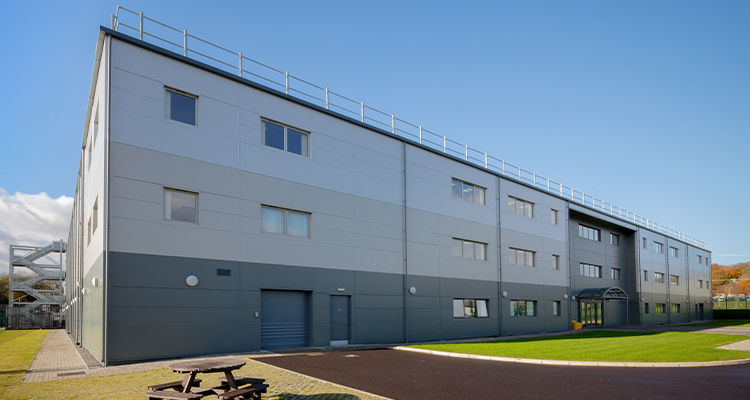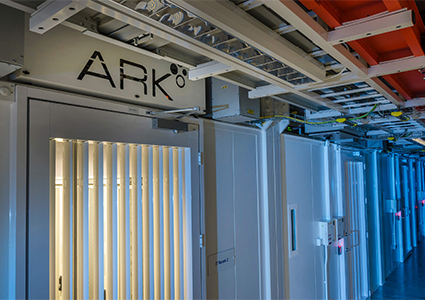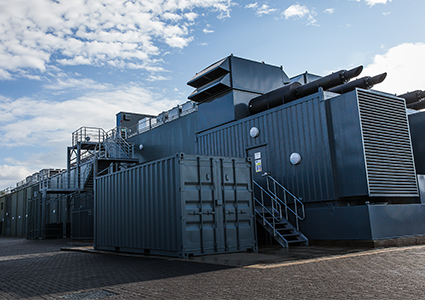
Changing mentality
How is Ark Data Centres ensuring the sustainability of its own operations, as well as educating end users?
Established in 2005, Ark Data Centre’s (Ark) objective has always been to design, build and operate sustainable data centres. Between 2005 and 2008, Pip Squire was working as a consultant to the owner when he was asked to join the new venture. “So, I joined in January 2008 as Director of Engineering and Projects to create our initial data centre at Spring Park in 2008. The business has really grown since then,” he shares. Pip is now Head of Energy and Sustainability, and in our conversation, he breaks down the reality of the data ecosystem as the industry transitions to more AI-supported operations.
 “Ark has been very focused on design, build and operate for third parties. We own the campuses and data centres that we design, build, and operate. Our first campus is at Spring Park, Wiltshire, which began operations in 2010. Our second one is at Cody Park, which is near Farnborough in Hampshire, and came online in 2011. We’ve got a third data centre in Enfield, which takes power from the local London Energy Ltd energy from waste plant via a direct wire power purchase agreement that started operations in 2021. We’ve also got in excess of 200kW(IT) in new facilities under development across three new campuses,” Pip highlights.
“Ark has been very focused on design, build and operate for third parties. We own the campuses and data centres that we design, build, and operate. Our first campus is at Spring Park, Wiltshire, which began operations in 2010. Our second one is at Cody Park, which is near Farnborough in Hampshire, and came online in 2011. We’ve got a third data centre in Enfield, which takes power from the local London Energy Ltd energy from waste plant via a direct wire power purchase agreement that started operations in 2021. We’ve also got in excess of 200kW(IT) in new facilities under development across three new campuses,” Pip highlights.
According to Pip, the business’ continued success is owed in a large part to its focus on availability, security, and sustainability. As a specialist in data centre construction and associated build, Ark’s leading strategy is to achieve sustainable solutions without sacrificing quality. “We aim to meet all key requirements in our facilities. ‘Availability’ means we focus on maintaining the power and cooling systems to the customer’s equipment always on, ‘Security’ is ensuring that our facilities and the customer equipment in them are only accessible to those with the appropriate authorisation, whilst ‘Sustainability’ is focusing on how we reduce our footprint on the planet as far as possible. We’ve done this by maintaining sustainability as a key business objective and applying a process of continuous evolution. Our first centre in 2009 was built with a traditional approach, but we’ve since moved quickly into the use of energy efficient direct fresh air-cooling technology and modular construction to improve on the sustainability value, without comprising the others.”
One of the consequences of the energy efficient cooling technology employed is the amount of water used in the evaporative cooling stages. “We realised early on that water preservation is as important as energy savings, so we started building rainwater harvesting systems into our base facilities from 2012. We collect rainwater from the roofs of our buildings, and in certain campuses, we use the attenuation ponds in our surface water drainage system. These ponds become a water source for the evaporative cooling systems. Ultimately, we aim to minimise our impact on the local water utility during normal operations. In our new facilities we have systems in place to optimise our water rainwater storage in response to ambient conditions such that in a normal year we should not need to use any utility water at all. We are determined to reduce our energy and water consumption to the minimum amount required to meet customer usage.
“In addition to our focus on energy and water, we have also adopted a factory-first approach to our construction process, where we build as much as we can in a factory. The modules are then delivered like a flat pack IKEA set, so all we have to do is prepare foundations for columns, which are steel, and the ground floor slab, we are then good to go. It saves time, energy and doesn’t impact quality.
“The process minimises adverse weather impacts and makes the construction process safer, because much of the work is carried out at ground level, rather than on the second or third floor for example. Everything is constructed and delivered in sequence and because we’re minimising the concrete elements, we immediately reduce our embedded carbon impact and increase our ability to recycle at end-of-life.”
Asking the right questions
 According to Pip, data centres are receiving bad raps, and he is on a mission to change that mentality. “Over the last ten years, as a sector, we have taken huge steps to make our systems much more efficient. Our cooling systems have gone from taking up to 70 per cent of the total facility load in the 2000’s to less than six per cent today. As a result, our total power consumption within the data centre specifically has not radically increased to reflecting the increased processing loads we see today. Instead, the total load has grown very slowly, because of the efficiencies that we have implemented.” In his opinion, “in terms of energy efficiency we have now pushed the laws of physics to their limits. To gain more efficiencies we need to work with customers and individuals to ensure their systems take advantage of the efficiencies we have built into ours and to change the operating parameters we must comply with, to allow for further efficiencies to be gained.”
According to Pip, data centres are receiving bad raps, and he is on a mission to change that mentality. “Over the last ten years, as a sector, we have taken huge steps to make our systems much more efficient. Our cooling systems have gone from taking up to 70 per cent of the total facility load in the 2000’s to less than six per cent today. As a result, our total power consumption within the data centre specifically has not radically increased to reflecting the increased processing loads we see today. Instead, the total load has grown very slowly, because of the efficiencies that we have implemented.” In his opinion, “in terms of energy efficiency we have now pushed the laws of physics to their limits. To gain more efficiencies we need to work with customers and individuals to ensure their systems take advantage of the efficiencies we have built into ours and to change the operating parameters we must comply with, to allow for further efficiencies to be gained.”
When considering the end-to-end data ecosystems Pip highlights that we need to consider the internet as though it is a global utility with ‘end users’ (IT equipment used by people, businesses, and processes), connected via ‘networks’ (wires/fibre/wireless/satellite transition systems), to ‘processing/storage centres’ (data centres). If we consider the energy used by this global utility (approximately four per cent of global energy demand) some 50 per cent of the energy consumed is through ‘end-user’ devices. “There are so many of them and they are always on,” he says. “How many people turn their phones off at night? Televisions, tablets, iPads: they are all consuming energy, even though they are not doing much”; 25 per cent of the energy consumed is by the ‘networks’; leaving 25 per cent consumed in the energy centre. Of the energy consumed in the data centre 85 per cent is consumed by the IT systems the data centre supports, only 15 per cent of the data centre consumption is to support the IT systems we are all using. In other words, data centres per se do not use four per cent of global energy consumption, they use less than 0.2 per cent of global energy consumption. It is our insatiable use and demand for data that is driving the energy consumption of the global internet.
“So, my goal, when it comes to sustainability, is to make users aware of the impact that their IT behaviours have on global energy consumption and to ask questions such as: ‘Do we need to store ALL data, ALL the time, FOR ALL time?’ ‘How many photographs are stored, multiple times on the internet and never looked at? They are literally burning energy’. ‘If you are live streaming a movie on a mobile device on a train doing 90mph, the amount of energy you are using end-to-end all the way through the system is the equivalent of a microwave cooking your porridge.’
“Over the past ten years we have focused on energy and water efficiency, at Ark these are now ‘business as usual’ practices. With the Climate Crisis now on us we have moved to a more holistic Carbon Reduction Plan to be a Net Zero company by 2030, with 2019 as our baseline year. Since then, we have been recording and reporting CO2e emissions in line with the Green House Gas Protocols. This work has shown, given that we use 100 per cent certified green energy, that our biggest operational CO2e emissions arise as a consequence of refrigerant gas losses from our standby cooling equipment. In 2020 and 2021 we implemented changes to FGas maintenance protocols and processes that reduced our 2019 losses by 75 per cent. We are looking at ways of replacing current refrigerant gases with new lower GWP gases and on new facilities we are working with customers and suppliers to provide a compressor – less cooling solution and so avoid the use of refrigerant gases as far as possible.”
Pip’s work is intricate, and although it has stressful moments, it can also be rewarding. In bringing our conversation to a close, he highlights the milestones of Ark’s evolution, and ties in his personal favourites. “Over the last 16 years, I have seen our three operational campuses, which were derelict facilities, turned into state-of-the-art data centre campuses with not just building efficiencies but also biodiversity built into them. We have conservation areas with, for example,
beehives and bat caves, and land management practices to encourage biodiversity all of which has been rewarding and ‘cool’ to witness.
“In terms of business sustainability, the thing that brings me the most pleasure is seeing us mature. We now measure our energy, water, and carbon emissions in a lot more detail than when we started. We have more resources that allow us time to think and analyse our performance based on the data we collect, and then find more efficient solutions to optimise workflows. Before I joined Ark, I was part of a large US Engineering Construction, that built power systems, water systems and telecom systems all around the world. It was the expertise I gained through that experience which I then applied to Ark, which is exciting.”
Pip’s insight into how sustainability intertwines with data centres and data usage demonstrates the way in which data centres are often maligned and the implications of data usage, impacts more than meets the eye. His hope is that other businesses will tap into this knowledge to optimise their own operations, and continue to make the construction industry a greener, safer, more sustainable place to work.